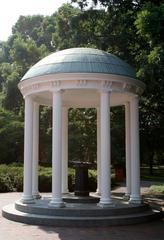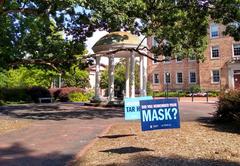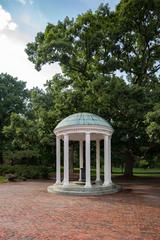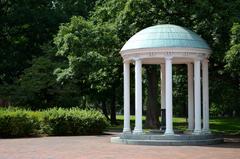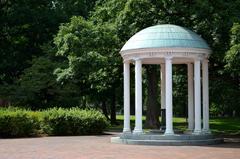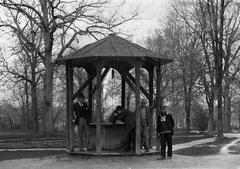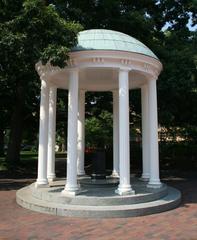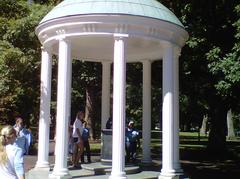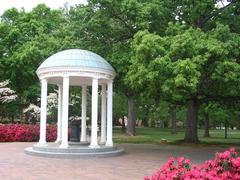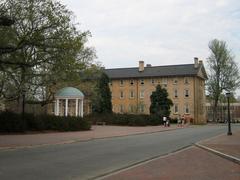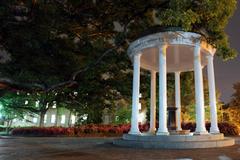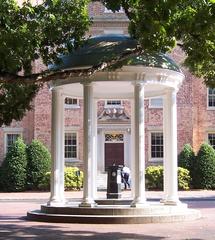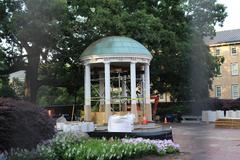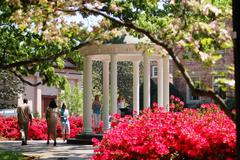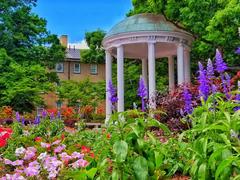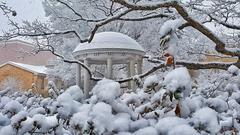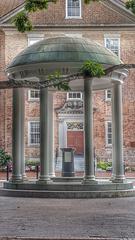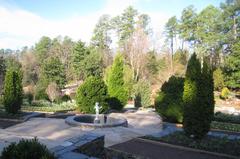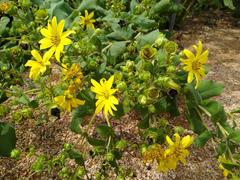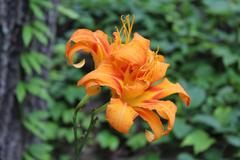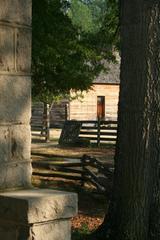
Guide to Visiting Old Well, Durham, United States
Publication Date: 24/07/2024
Introduction to the Old Well
The Old Well in Durham, North Carolina, is not merely an architectural fixture but a profound emblem of the region’s rich history and cultural heritage. Situated on the campus of Duke University, this historical landmark serves as a poignant reminder of the area’s transformation from Native American settlements to a bustling hub of education and industry. This comprehensive guide seeks to provide visitors with an insightful narrative on the Old Well’s significance, practical information for planning a visit, and tips to enhance the overall experience. Whether you are a history enthusiast, a prospective student, or a casual visitor, this guide will equip you with all the necessary knowledge to appreciate the Old Well’s enduring legacy.
Contents Overview
- Introduction
- Early Beginnings and Native American Influence
- European Settlement and Colonial Era
- Revolutionary War and Antebellum Period
- The Birth of Durham and the Tobacco Industry
- The Establishment of Duke University
- The Old Well and Its Significance
- Preservation and Modern-Day Relevance
- Visitor Information
- Best Time to Visit
- Guided Tours
- Photography
- Nearby Attractions
- Visiting Hours
- Tickets
- Special Events and Activities
- FAQ
- Accessibility
- Guided Tours
- Pets
- Conclusion
Visiting the Old Well - Durham’s Historical Gem – Hours, Tickets, and Tips
Introduction
The Old Well is not just a historical landmark; it is a symbol of the rich history and enduring legacy of Duke University and the city of Durham, North Carolina. This article will take you through the fascinating history of the Old Well, provide practical information for visitors, and share tips to make the most of your visit to this iconic site.
Early Beginnings and Native American Influence
The history of Durham, North Carolina, where the Old Well is located, dates back to long before European settlers arrived. The area was originally inhabited by Native American tribes, including the Eno and the Occaneechi, who were related to the Sioux. These tribes established settlement sites, transportation routes, and environmentally-friendly patterns of natural resource use (Museum of Durham History).
European Settlement and Colonial Era
In 1701, the beauty of Durham was chronicled by the explorer John Lawson, who referred to the area as “the flower of the Carolinas.” During the mid-1700s, Scots, Irish, and English colonists began to settle on land granted to John Carteret, Earl of Granville, by King Charles I. Early settlers built gristmills and worked the land, laying the foundation for what would become a thriving community (Museum of Durham History).
Revolutionary War and Antebellum Period
Prior to the American Revolution, frontiersmen in what is now Durham were involved in the “War of Regulators.” This conflict was a precursor to the larger revolutionary struggle against British rule. During the Revolutionary War, local shopkeeper and farmer William Johnston played a significant role by forging ammunition and supporting Daniel Boone’s westward explorations (Museum of Durham History).
The Birth of Durham and the Tobacco Industry
Durham itself was named for Dr. Bartlett Durham in the 1800s. The town quickly grew, thanks in large part to the tobacco industry. Washington Duke and his family discovered Brightleaf tobacco, which led to the establishment of one of the world’s largest tobacco corporations, including American Tobacco, Liggett & Myers, R.J. Reynolds, and P. Lorillard (Museum of Durham History).
The Establishment of Duke University
Around the same time that the tobacco industry was booming, the trustees of Trinity College were looking for a new campus. In 1889, they accepted Durham’s offer of 62 acres donated by Julian Carr and $85,000 from Washington Duke. This land would eventually become Duke University. The design of Duke’s East Campus largely follows the layout of the original racetrack that existed there (Old West Durham History).
The Old Well and Its Significance
The Old Well, located on the campus of Duke University, is a significant historical landmark. It is a symbol of the university’s rich history and its transformation from a small college to a world-renowned institution. The well itself is a testament to the early days of the university and the community that supported its growth.
Preservation and Modern-Day Relevance
Today, the Old Well is preserved as part of the university’s commitment to maintaining its historical landmarks. It serves as a reminder of the university’s humble beginnings and its journey to becoming a leading educational institution. The well is also a popular spot for students and visitors, who often stop to take photos and reflect on the history of the university (Old West Durham History).
Visitor Information
For those planning to visit the Old Well, here are some tips to make the most of your experience:
- Best Time to Visit - The well is accessible year-round, but the best time to visit is during the spring and fall when the weather is pleasant, and the campus is in full bloom.
- Guided Tours - Consider taking a guided tour of Duke University to learn more about the history of the Old Well and other significant landmarks on campus.
- Photography - The Old Well is a popular spot for photography, so bring your camera to capture the beauty and history of this iconic landmark.
- Nearby Attractions - While on campus, be sure to visit other historical sites such as Duke Chapel and the Sarah P. Duke Gardens.
- Visiting Hours - The Old Well is open to visitors 24/7, making it a convenient stop any time of day.
- Tickets - There is no admission fee to visit the Old Well, but guided tours may have associated costs. Check the Duke University website for the most current information.
Special Events and Activities
Throughout the year, Duke University hosts various events at and around the Old Well. These events often include historical reenactments, lectures, and student-led activities. Check the university’s event calendar for upcoming events during your visit.
FAQ
Q: Is the Old Well accessible for people with disabilities? A: Yes, the Old Well and the surrounding area are accessible for people with disabilities.
Q: Are there any guided tours available specifically for the Old Well? A: While there are no tours exclusively for the Old Well, it is included in the general campus tours offered by Duke University.
Q: Can I bring pets to the Old Well? A: Pets are allowed on campus but must be on a leash and cleaned up after.
Conclusion
The Old Well is more than just a historical landmark; it is a symbol of the rich history and enduring legacy of Duke University and the city of Durham. Its preservation and continued relevance serve as a testament to the community’s commitment to honoring its past while looking forward to the future. Whether you are a history enthusiast, a student, or a visitor, the Old Well offers a unique glimpse into the history of one of North Carolina’s most storied institutions.
Call to Action
If you found this article helpful, be sure to follow us on social media for more updates on historical sites and tips for visiting Durham. Also, check out our other articles on Durham’s historical landmarks and plan your next visit today!
Summary and Key Points
In conclusion, the Old Well at Duke University in Durham stands as a testament to the rich tapestry of history that has shaped the region. From its roots in Native American culture and early European settlement to its pivotal role in the growth of the tobacco industry and the establishment of Duke University, the Old Well encapsulates a journey of transformation and progress. Today, it remains a cherished symbol of the university’s heritage and a popular destination for visitors. By preserving this landmark, Duke University not only honors its past but also inspires future generations to appreciate and learn from it. Whether you visit to delve into its historical significance, capture its beauty through photography, or participate in longstanding traditions, the Old Well offers a unique and enriching experience that resonates with all who encounter it. For more information and updates, be sure to check out related articles and follow us on social media.
Sources and Further Reading
- Museum of Durham History. (n.d.). Overview of Durham History Museum of Durham History
- Old West Durham History. (n.d.). History of Duke University Old West Durham History
- UNC Museum. (n.d.). The Old Well UNC Museum
- Wikipedia. (n.d.). Old Well Wikipedia
- UNC Discover. (n.d.). The Old Well You Never Knew UNC Discover
- Visit Chapel Hill. (n.d.). Old Well Visit Chapel Hill
- WUNC. (2023, August 23). Old Well Accessibility Updates WUNC
- Morehead Planetarium. (n.d.). Morehead Planetarium
- Ackland Art Museum. (n.d.). Ackland Art Museum
- Coker Arboretum. (n.d.). Coker Arboretum
- Top of the Hill. (n.d.). Top of the Hill
- Mediterranean Deli. (n.d.). Mediterranean Deli
- Sutton’s Drug Store. (n.d.). Sutton’s Drug Store
- UNC Student Stores. (n.d.). UNC Student Stores
- UNC Visitors Center. (n.d.). UNC Visitors Center
